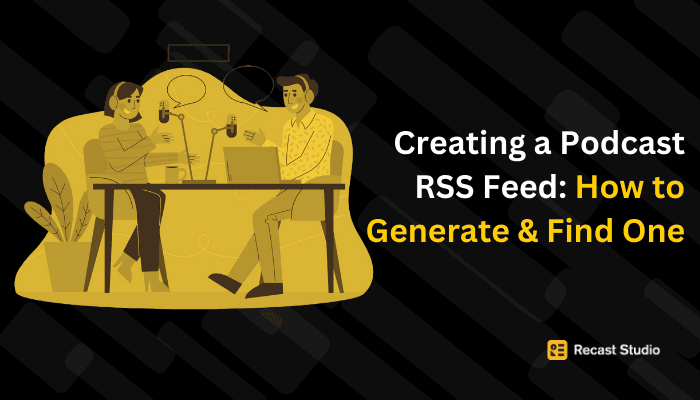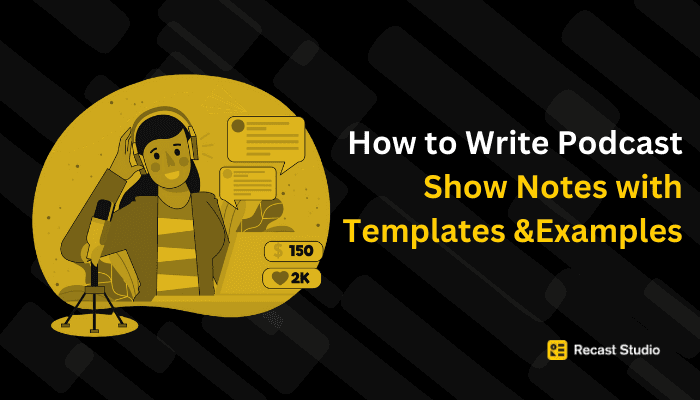Podcasting
How To Start a Video Podcast In 2024 (Step-By-Step Guide)
Starting your Video podcast can be daunting, so here’s your step by step guide to launch your video podcast today. Everything you need to know from types of podcast to video podcast setup at once place.
5 apr 2024
So are you ready to leap into the world of video podcasts in 2024? Curious minds, buckle up. We're about to embark on a journey where pixels meet passion, and cameras capture conversations.
Video Podcasts have become an indispensable tool for individuals and businesses alike to connect with their target demographic. Moreover, as we navigate through 2024, the relevance of video podcasting has only amplified.
But, why should you consider starting a video podcast in 2024? Why not an audio podcast or something else? The benefits are plentiful. Firstly, video podcasts allow for enhanced storytelling and engagement, fostering deeper connections with your audience.
With the rise of platforms like YouTube, TikTok, and Instagram, video content has become more accessible and shareable. The exponential growth of video podcasts is a testament to their increasing popularity. By 2024, Statista predicts that the number of podcast listeners in the United States will exceed 100 million.
Moreover, according to a report by Cumulus Media and Signal Hill Insights, around 55.5% of YouTube users express a preference for video content within podcasts.
In this step-by-step guide, we'll explore starting a video podcast in 2024. We'll provide essential knowledge and tools for your podcasting journey. Whether you're a seasoned podcaster or a newcomer, this guide is for you.
Table of Contents:
What are the Types of Video Podcasts?
How do you start a video podcast?
Step 1: Planning Your Video Podcast
Step 2: Crafting Your Content
Step 3: Technical Setup
Step 4: Launching Your Video Podcast
Step 5: Promoting Your Video Podcast
Step 6: Monetizing Your Video Podcast
Conclusion:
Frequently Asked Questions (FAQs)
What are the Types of Video Podcasts?
Ever wondered about the different types of video podcasts? Let's break it down:
Solo Video Podcast:
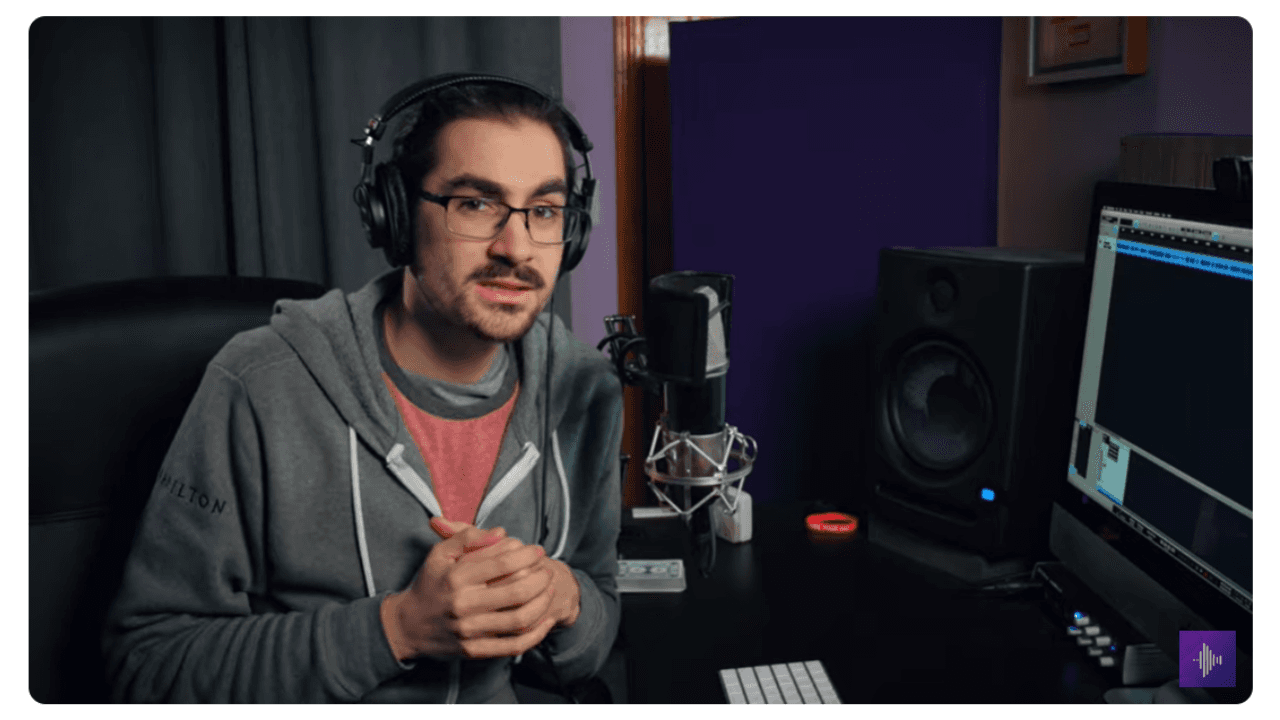
These are podcasts where one person talks on their own, sharing thoughts, ideas, or stories directly with the audience. It's a great format for personal reflections or sharing expertise in a focused manner. Moreover, solo monologues are not only a platform for self-expression but also an opportunity for creators to connect deeply with their audience.
Interview Video Podcast:

In this type, a host talks with one or more guests, asking questions and discussing various topics. It's like having a conversation on camera. Interviews can provide valuable insights from experts. Furthermore, offer entertaining discussions with interesting personalities.
Roundtable Video Podcast:
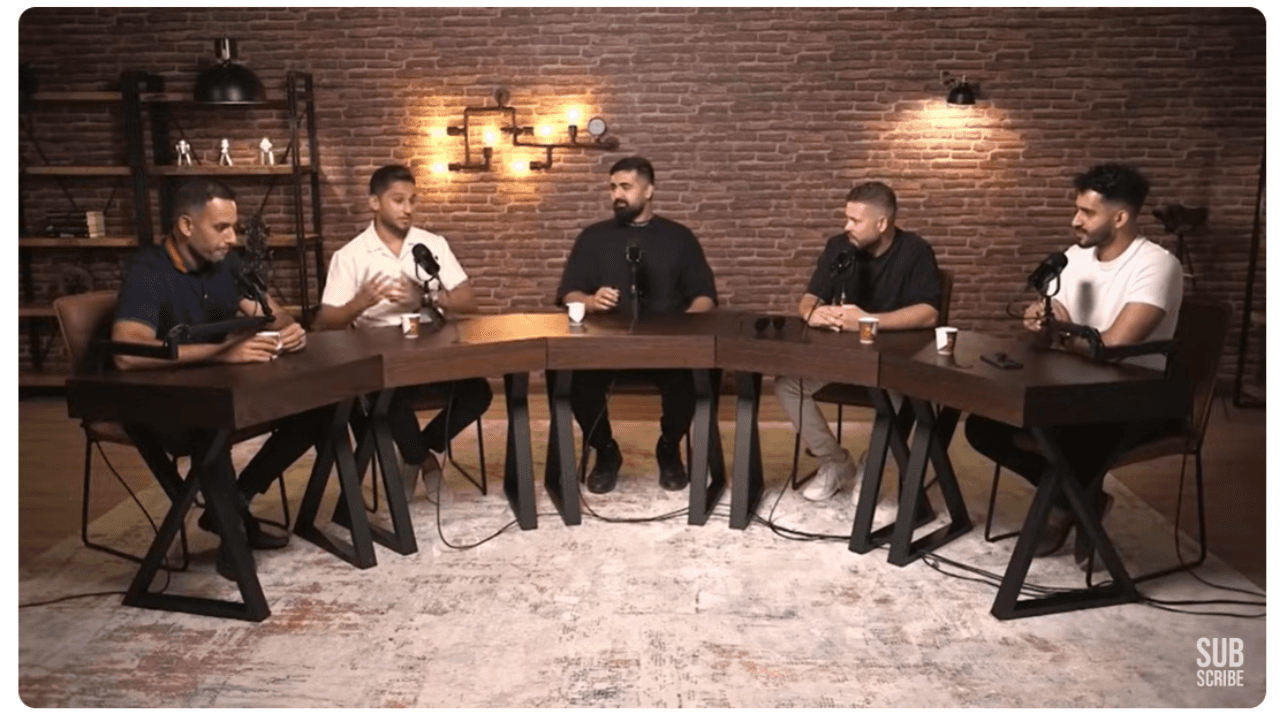
Picture a group of people sitting around a table, chatting about a particular subject. That's what roundtable discussions are about - multiple participants sharing their perspectives and insights. These podcasts often feature lively debates. Additionally, they provide diverse viewpoints on current events, industry trends, or niche topics.
Storytelling Episodes:
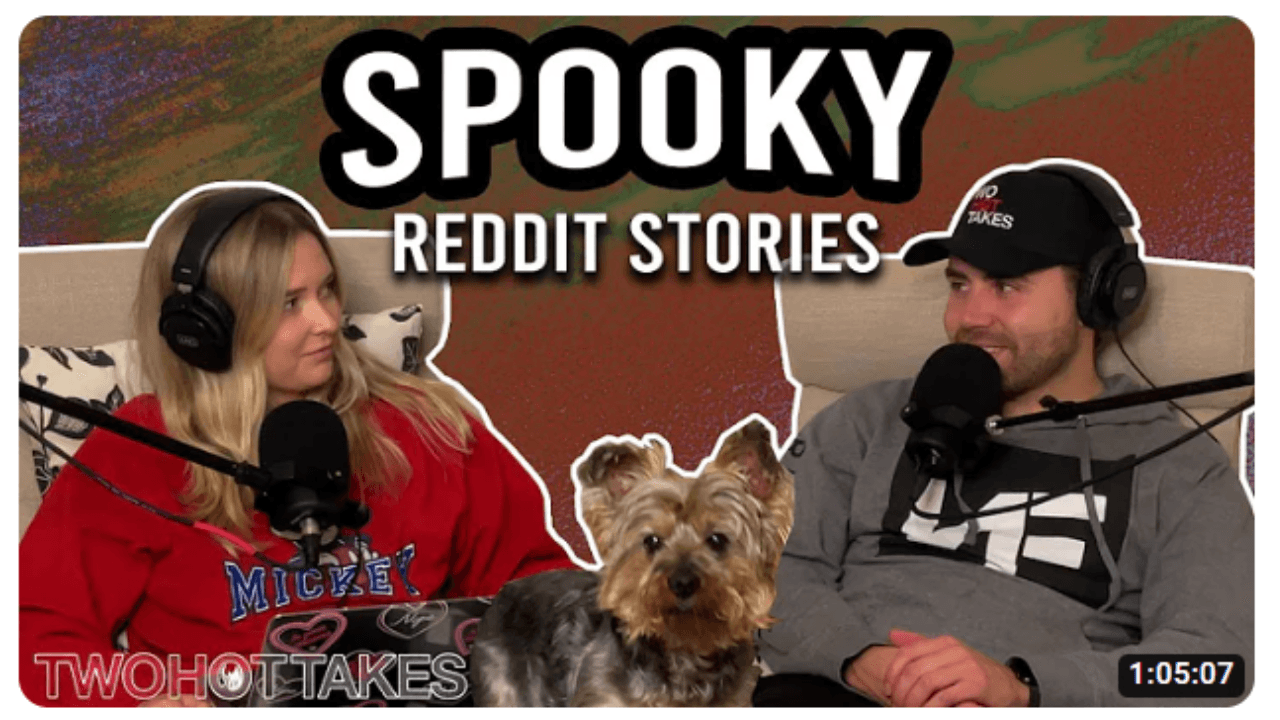
Just like it sounds, storytelling episodes involve narrating a tale or recounting real-life experiences engagingly and entertainingly. Whether it's sharing personal anecdotes, exploring historical events, or diving into fictional narratives, storytelling podcasts captivate audiences with compelling narratives and vivid imagery.
Each type offers a unique experience for both creators and viewers, so pick the one that suits your style best and get ready to hit the record.
How to start a video podcast in 2024?
Starting a video podcast may seem daunting, but with the right steps, it's just a room away. Here's a guide to help you kick off your video podcast journey in 2024.
Step 1: Planning Your Video Podcast
Before diving into the technical aspects of creating a video podcast, it's crucial to lay a solid foundation through meticulous planning. This Step will walk you through the essential steps to ensure that your video podcast aligns with your objectives.
Identifying Your Niche:
The first step in planning your podcast video is to identify your niche. Consider what topics or themes you're passionate about and where your expertise lies. Your niche will define the overarching theme of your podcast and help you stand out in a crowded digital landscape.
Additionally, you can take reference from Pod Sound School’s 50 creative podcast ideas. In short, whether it's technology, or entrepreneurship, selecting a niche that resonates with you will make it easier to produce engaging content.
Understanding Your Audience:
Once you've determined your niche, it's vital to understand your target audience. You need to focus on three things to gain insights into what content will appeal to them. These are:
Demographics
Interests
Preferences
Moreover, Consider conducting surveys or engaging with your audience on social media platforms to gather feedback. Understanding your audience will enable you to create content that resonates with them and fosters a loyal following.
Setting Clear Goals:
Define clear goals for your video podcast to keep your efforts focused and measurable. Figure out if you are looking to
Increase brand awareness
Drive traffic to your website, or
Monetize your podcast through sponsorships.
Setting specific, achievable goals will guide your content strategy and help you track your progress over time. Whether it's reaching a certain number of subscribers, or generating a specific amount of revenue, having clear goals will provide direction.
Step 2: Crafting Your Content
Now that you've established the groundwork for your video podcast, it's time to delve into the creative process of crafting compelling content.
Episode Formats:
Explore different episode formats to keep your content fresh and engaging. Some of the most popular video podcast formats are:
Solo monologues
Interviews
Roundtable discussions, and
Storytelling episodes.
Remember, varying your format adds diversity to your content. Moreover, it caters to different audience preferences. Therefore, experiment with different formats to discover what resonates best with your audience and keeps them coming back for more.
Content Planning:
Develop a content calendar to stay organized and consistent with your uploads. Outline topics for each episode, taking into account current trends, audience feedback, and your niche expertise.
Additionally, consider creating themed series or recurring segments to structure your content and keep your audience eagerly anticipating each new episode. Thus, by planning your content, you'll ensure a steady flow of high-quality podcast videos and maintain engagement.
Scripting vs. Improvisation:
Decide whether you'll script your episodes in advance or opt for a more spontaneous, improvisational approach. Scripting provides structure and ensures that you cover all key points effectively, but it may come across as less authentic.
On the other hand, improvisation allows for spontaneity and authenticity but requires quick thinking and may lead to tangents or rambling. Find the right balance between scripting and improvisation. Furthermore, consider your comfort level and the nature of your content.
For example, Some podcasters prefer a loose outline to guide their discussions, while others prefer a word-for-word script. Therefore, experiment with both approaches to determine what suits your style and resonates best with your audience.
Step 3: Technical Setup
Setting up the technical aspects of your video podcast is crucial to ensuring high-quality audio and video production. In this Step, we'll cover everything you need to know to create a professional-looking and sounding podcast.
Choosing the Right Equipment:
Invest in quality audio and video podcast equipment to elevate the production value of your podcast. For audio, consider purchasing a high-quality microphone to ensure clear and crisp sound. Popular options include:
USB microphones for beginners, and
XLR microphones for professional-grade audio.
Additionally, invest in headphones to monitor audio levels and ensure optimal sound quality during recording. Similarly, for video, choose a camera that can capture high-definition footage, such as:
A smartphone with a high-quality camera.
Also, don't forget to invest in lighting equipment to ensure a well-lit and visually appealing video podcast. Moreover, take help from this Spotify guide to calculate your budget and goals.
Setting Up Your Recording Space:
Create a dedicated recording space free from background noise and distractions. There are certain things that you need:
A quiet room with minimal echo
Soundproofing if possible.
Decorate the space with branding elements or
A backdrop that reflects the theme of your podcast.
Moreover, position your microphone and camera at optimal angles to capture clear audio and video, and test the lighting to ensure even illumination. This way you will be able to create a perfect video podcast setup. Additionally, you can refer to Austin Mardriaga’s Video podcast tour to get an idea.
Recording and Editing Best Practices:
Familiarize yourself with video podcast software to refine your podcast episodes. Popular options for audio editing include:
Audacity
Adobe Audition, or
GarageBand.
Record multiple audio and video tracks separately to allow for easier editing and post-production. Moreover, pay attention to audio levels during recording to prevent clipping or distortion.
Also, when editing focus on these things to enhance the visual appeal of your videos:
Trim unnecessary footage
Add transitions and overlays, and
Incorporate graphics or animations
Recast Studio, for example, allows you to add automatic captions, audiogram animations, and animated text without hassle.
Step 4: Launching Your Video Podcast
Launching your video podcast is an exciting milestone in your podcasting journey. In this Step, we'll cover key steps to ensure a successful launch. Furthermore, we will look at how to maximize your podcast's visibility.
Branding Your Podcast:
Develop a strong brand identity for your podcast to distinguish it from the competition and attract your target audience. For instance, design a captivating logo and choose a color scheme that aligns with your podcast's theme and tone.
Furthermore, create branded graphics and promotional materials for your podcast, including cover art for episodes and social media banners. In short, consistent branding across all platforms will help establish your podcast's identity and foster recognition among your audience.
Creating a Launch Plan:
Plan a strategic launch for your podcast to generate excitement and anticipation among your audience. Develop a launch schedule outlining when episodes will be released and how you'll promote them across various channels. For example, if you are planning a Spotify video podcast, use Spotify ads to create a buzz.
Moreover, consider hosting a launch event or giveaway to incentivize listeners to tune in to your podcast. Additionally, leverage your existing networks and social media platforms to spread the word about your podcast.
Distribution Platforms:
Choose the right distribution platforms to reach a wider audience and maximize the visibility of your podcast. Popular platforms for video podcast hosting podcasts include:
Ensure your podcast is optimized for each platform by submitting compelling descriptions, tags, and cover art.
Additionally, consider promoting your podcast on social media platforms like Instagram, Twitter, and Facebook to reach potential listeners. Thus, by diversifying your distribution channels, you'll increase the discoverability of your podcast. Moreover, you can attract new listeners from different demographics.
Step 5: Promoting Your Video Podcast
Promoting your video podcast is essential for expanding your audience reach and increasing engagement. Let’s learn the effective strategies for promoting your podcast and attracting new listeners.
Social Media and Content Marketing:
Leverage social media platforms to promote your video podcast and engage with your audience. To create curiosity and encourage viewers:
Share teaser clips
Behind-the-scenes footage, and
Highlights from your episodes
For instance, with Recast Studio’s AI shorts and Podcast clip generator feature, you can generate 30+ high-quality sharable clips in a single minute.
Also, Create compelling graphics and captions to accompany your posts and drive traffic to your podcast. Additionally, consider repurposing your podcast content into:
Blog posts
Newsletters, or
Infographics to reach audiences across different channels.
You can use Recast Studio to create blog posts from your video podcasts.
Collaborations and Guest Appearances:
Collaborate with other podcasters, influencers, or experts in your niche to expand your podcast's reach and tap into their existing audience base.
For instance, guest appearances on other podcasts allow you to showcase your expertise and introduce yourself to new listeners.
Similarly, invite guests to your podcast to provide fresh perspectives and attract their followers to your content. Moreover, cross-promoting each other's podcasts can lead to mutually beneficial relationships and increase visibility for both parties.
SEO and Analytics:
Optimize your video podcast for search engines by incorporating relevant keywords, tags, and descriptions into your episode titles and metadata. This will improve the discoverability and attract organic traffic from search engine results.
Monitor your podcast's performance using analytics tools to track key metrics such as downloads, listens, and audience demographics. Analyzing this data will help you understand your audience's preferences.
Thus, allowing you to fine-tune your content and promotion strategies for maximum impact.
Step 6: Monetizing Your Video Podcast
Turning your passion for podcasting into a profitable venture requires strategic monetization efforts. Explore these key strategies to monetize your video podcast effectively.
Monetization Strategies:
Consider various monetization avenues such as:
Sponsorships
Affiliate marketing
Merchandise sales, and
Premium content subscriptions.
Partnering with relevant brands for sponsorships can generate revenue through sponsored content or ad placements within your episodes.
For example, affiliate marketing involves promoting products or services and earning a commission for referrals. Additionally, selling branded merchandise or offering premium content behind a paywall can provide additional revenue streams for your podcast.
Building a Community:
Cultivate a loyal community around your video podcast by engaging with your audience on social media and hosting live events or Q&A sessions.
Building a strong community is essential. It fosters a sense of belonging. It also creates monetization opportunities. These include memberships, donations, or crowdfunding campaigns.
Tips for Sustainable Growth:
Focus on sustainable growth by consistently delivering high-quality and nurturing relationships with your audience and collaborators. Invest in audience engagement and retention strategies to keep listeners coming back for more.
Moreover, continuously evaluate and refine your monetization strategies based on feedback and analytics to optimize revenue generation.
Conclusion:
In conclusion, launching a video podcast in 2024 is an exciting venture that's more accessible than ever before. By following these step-by-step guidelines, you can turn your ideas into captivating content that resonates with audiences worldwide.
So why wait? Grab your camera, unleash your creativity, and start sharing your stories with the world through the power of video podcasting today. Moreover, recording and editing software like Recast Studios and Audacity are there to help you in each step.
So, ready to take the plunge? Share your thoughts and questions in the comments below, and let's embark on this journey together.
Frequently Asked Questions (FAQs)
What is a video podcast?
A video podcast is like a regular podcast, but with video added. It's a show you can watch, not just listen to.
What are some video podcast equipment for beginners?
You can start with just a smartphone or webcam to record. Moreover, you need a microphone for good sound, and some basic lighting. Moreover, use free or affordable software to edit your videos.
How to change a video to a podcast?
To turn a video into a podcast, you take the audio from the video and publish it like a regular podcast. You remove the video but keep the sound. Consequently, you upload it to a podcast platform.
How to start a video podcast for free?
You can start for free by using free recording and editing software, like OBS Studio or iMovie. After that, use your phone or computer camera to record, and then host your podcast for free on platforms like Anchor.
Is video podcasts better than audio?
It depends on what you prefer and the content. Video podcasts let you see as well as hear, which can be helpful for some topics. However, audio podcasts are easier to listen to on the go and don't need your full attention. Thus, choose what works best for you.
Latest articles
Ai Powered
Marketing Assistant for Your Podcast
A generative AI tool that automatically turns your podcast episode into short video clips & writes show notes, blog posts, social media posts and more in minutes.
